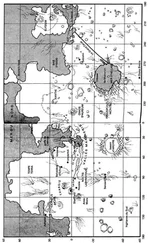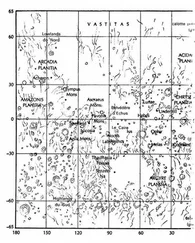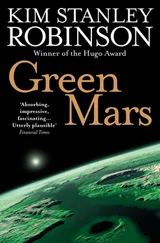“We should join whoever we can, and help fight!” Angela said.
“I’m not fighting anyone,” Nadia said mulishly. “It’s stupid. I won’t do it. I’ll fix things where I can, but I won’t fight.”
A message came over the radio. Fournier Crater, about 860 kilometers away, had a cracked dome. The populace was trapped in sealed buildings, and running out of air.
“I want to go there,” Nadia said. “There’s a big central warehouse of construction robots there. They could fix the dome, and then be set to other repairs down on Isidis.”
“How will you get there?” Sam asked.
Nadia thought it over, took a deep breath. “Ultralite, I guess. There’s some of those new 16Ds up on the south-rim airstrip. That would be the fastest way for sure, and maybe even the safest, who knows.” She looked at Yeli and Sasha. “Will you fly with me?”
“Yes,” Yeli said. Sasha nodded.
“We want to come with you,” Angela said. “It’ll be safer with two planes anyway.”
They took two planes that had been built by Spencer’s aeronautic factory in Elysium, the latest things, called simply 16Ds, ultralite delta-winged four-seat turbojets, made mostly of areogel and plastics, dangerous to fly because they were so light. But Yeli was an expert flier and Angela said she was too, so they climbed into two of them the next morning, after spending the night in the empty little airport, and taxied out to the packed dirt runway and took off directly into the sun. It took them a long time to rise to a thousand meters.
The planet below looked deceptively normal, its old harsh face only a bit whiter on the north faces, as if aged by its parasite infestation. But then they flew out over Arena Canyon, and saw running down it a dirty glacier, a river of broken ice blocks. The glacier widened frequently where the flood had pooled for a time. The ice blocks were sometimes pure white, but more often stained one Martian shade or other, then broken and tumbled into a mix, so that the glacier was a shattered mosaic of frozen brick, sulfur, cinnamon, coal, cream, blood. . spilling down the flat bed of the canyon all the way to the horizon, some seventy-five kilometers away.
Nadia asked Yeli if they could fly north and inspect the land that the robots were going to build the pipeline over. Soon after they turned they received a weak radio message on the first hundred band, from Ann Clayborne and Simon Frazier. They were trapped in Peridier Crater, which had lost its dome. It was to the north also, so they were already on the right course.
The land they crossed that morning appeared negotiable to the robot team; it was flat, and though littered with ejecta, there were no little stopper escarpments. Farther on in this region the Nili Fossae began, very gradually at first, just four very shallow depressions, curving down to the northeast like the fingertips of a faint handprint. A hundred kilometers farther north, however, and they were parallel chasms each 500 meters deep, separated by dark land that had been heavily bashed by craters— a kind of lunar configuration, reminding Nadia of a messy construction site. Farther north still, they got a surprise: where the easternmost canyon debouched onto Utopia, there was another aquifer outbreak. At its upper end it was simply a new slump, a big bowl of land shattered like a broken plate of glass; lower down, patches of frosting black-and-white water surged right out of the broken land, ripping at the new blocks and carrying them away even as they watched, in a steaming flood that caused the land it touched to explode. This shocking wound was at least thirty kilometers across, and ran right over the horizon to the north, with no sign of dissipating.
Nadia stared at the sight and asked Yeli to fly nearer. “I want to avoid the steam,” Yeli said, absorbed in the sight himself. Most of the white frost cloud was blowing east and falling down onto the landscape, but the wind was fitful, and sometimes the thin white veil would rise straight up, obscuring the swath of black water and white ice. The outflow was as big as one of the big Antarctic glaciers, or even bigger. Cutting the red landscape in two.
“That is a hell of a lot of water,” Angela said.
Nadia switched to the first hundred band, and called Ann down in Peridier. “Ann, do you know about this?” She described what they were flying over. “And it’s still running, the ice is moving, and we can see patches of open water, it looks black or sometimes red, you know.”
“Can you hear it?”
“Just sort of like a ventilator hum, and some cracks and pops from the ice, yeah. But we’re pretty loud up here ourselves. Hell of a lot of water!”
“Well,” Ann said, “that aquifer isn’t very big compared to some.”
“How are they breaking them open? Can people really break those open?”
“Some of them,” Ann said. “The ones with hydrostatic pressure greater than lithostatic pressure are in essence lifting the rock up, and it’s the permafrost layer that is forming a kind of dam, an ice dam. If you drilled a well and blew it up, or if you melted it. .”
“But how?”
“Reactor meltdown.”
Angela whistled.
“But the radiation!” Nadia cried.
“Sure. But have you looked at your counter lately? I figure three or four of them must have gone.”
“Wow!” Angela cried.
“And that’s just so far.” Ann’s voice had that distant, dead tone it took on when she was angry. She answered their questions about the flood very briefly. A flood that big caused extreme pressure fluctuations; bedrock was smashed, then plucked away, and it was all swept downstream in a pulverizing rush, a ripping, gaseous, boulder-filled slurry. “Are you going to come over to Peridier?” she asked when their questions trailed off.
“We’re just turning east now,” Yeli replied. “I wanted to get a visual fix on Crater Fv first.”
“Good idea.”
They flew on. The astounding roil of the flood dropped beneath the horizon, and they flew over the familiar old stone and sand again. Soon Peridier appeared over the horizon ahead, a low, much-eroded crater wall. Its dome was gone, tattered sheets of the fabric thrown aside, still rolling this way and that over the crater rampart, as if a seed pod had burst. The piste running south reflected the sun like a silver thread. They flew over the arc of the crater wall, and Nadia peered down at the dark buildings through binoculars, cursing in a low Slavic chant. How? Who? Why? There was no way to tell. They flew on to the airstrip out on the far crater rampart. None of the hangars was working, and they had to suit up and drive some little cars over the rim into town.
All the surviving occupants of Peridier were holed up in the physical plant. Nadia and Yeli went through its lock and gave Ann and Simon a hug, and then they were introduced to the others. There were about forty of them, living off emergency supplies, struggling to balance the gas exchange in the sealed buildings. “What happened?” Angela asked them, and they told the story in a kind of Greek chorus, interrupting each other frequently: a single explosion had burst the dome like a balloon, causing an instantaneous decompression that had also blown up many of the town’s buildings. Luckily the physical plant was reinforced, and had withstood the internal pressures of its own air supply; and those inside had survived. Those out on the streets, or in the other buildings, had not.
“Where’s Peter?” Yeli asked, startled and fearful.
“He’s on Clarke,” Simon said quickly. “He called us right after this all began. He’s been trying to get a spot on one of the elevators down, but it’s all police at this point, I guess there were a lot of them in orbit. He’ll get down when he can. It’s safer up there right now anyway, so I’m not in that much of a hurry to see him.”
Читать дальше
Конец ознакомительного отрывка
Купить книгу












